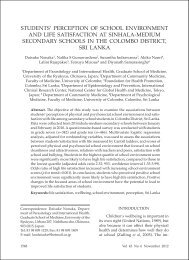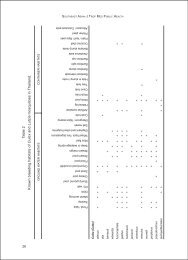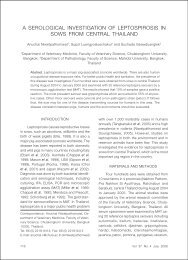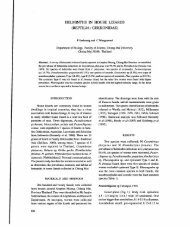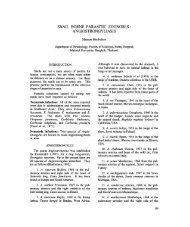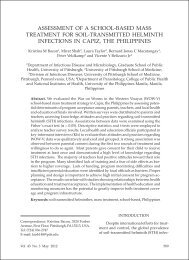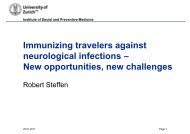bacterial meningitis incidence in thai children estimated by a rapid ...
bacterial meningitis incidence in thai children estimated by a rapid ...
bacterial meningitis incidence in thai children estimated by a rapid ...
You also want an ePaper? Increase the reach of your titles
YUMPU automatically turns print PDFs into web optimized ePapers that Google loves.
BACTERIAL MENINGITIS ESTIMATION BY RAPID ASSESSMENT TOOL<br />
BACTERIAL MENINGITIS INCIDENCE IN THAI<br />
CHILDREN ESTIMATED BY A RAPID ASSESSMENT TOOL<br />
(RAT)<br />
Charung Muangchana, Supamit Chunsuttiwat, Supachai Rerks-Ngarm and<br />
Prayura Kunasol<br />
Department of Disease Control, M<strong>in</strong>istry of Public Health, Nonthaburi, Thailand<br />
Abstract. Acute <strong>bacterial</strong> <strong>men<strong>in</strong>gitis</strong> is an important cause of morbidity and mortality<br />
<strong>in</strong> <strong>children</strong>. To estimate the <strong><strong>in</strong>cidence</strong> of <strong>men<strong>in</strong>gitis</strong> caused <strong>by</strong> all types of bacteria <strong>in</strong><br />
Thai <strong>children</strong> under five years of age, data were collected us<strong>in</strong>g a <strong>rapid</strong> assessment<br />
tool (RAT) and analyzed. Cl<strong>in</strong>ical and laboratory data from suspected <strong>men<strong>in</strong>gitis</strong> cases<br />
for a one-year period were retrospectively collected from 5 selected catchment areas<br />
located <strong>in</strong> the 4 regions of the country. Adjusted <strong><strong>in</strong>cidence</strong>s of confirmed <strong>bacterial</strong><br />
<strong>men<strong>in</strong>gitis</strong> were calculated based on laboratory quality and lumbar puncture rates.<br />
Seventy-five suspected <strong>men<strong>in</strong>gitis</strong> cases were identified among 305,023 <strong>children</strong> under<br />
age five <strong>in</strong> the catchment areas, with an unadjusted <strong><strong>in</strong>cidence</strong> of 24.6 per 100,000.<br />
Of these, 66.2, 55.9, and 33.8% were unconfirmed <strong>bacterial</strong>, purulent, and confirmed<br />
<strong>bacterial</strong> <strong>men<strong>in</strong>gitis</strong> cases, respectively. Among the confirmed <strong>bacterial</strong> <strong>men<strong>in</strong>gitis</strong> cases,<br />
39.1, 26.1, 21.7 and 13.0% were caused <strong>by</strong> Haemophilus <strong>in</strong>fluenzae type B, gram-positive<br />
cocci, gram-negative bacilli, and Neisseria men<strong>in</strong>gitidis, respectively. After adjust<strong>in</strong>g<br />
based on the RAT application, the <strong><strong>in</strong>cidence</strong> of confirmed <strong>bacterial</strong> <strong>men<strong>in</strong>gitis</strong> was<br />
about double that of the unadjusted <strong><strong>in</strong>cidence</strong>. This study gives an <strong>in</strong>terval of possible<br />
<strong><strong>in</strong>cidence</strong>s of <strong>bacterial</strong> <strong>men<strong>in</strong>gitis</strong> <strong>in</strong> <strong>children</strong> under age five, which is between the<br />
unadjusted (low estimate) and adjusted (high estimate) <strong><strong>in</strong>cidence</strong>s.<br />
INTRODUCTION<br />
Acute <strong>bacterial</strong> <strong>men<strong>in</strong>gitis</strong> is an important<br />
cause of morbidity and mortaility <strong>in</strong><br />
<strong>children</strong>. The three most common etiologic<br />
agents are Haemophilus <strong>in</strong>fluenzae type b<br />
(Hib), Streptococcus pneumoniae and Neisseria<br />
men<strong>in</strong>gitidis, which account for 90% of reported<br />
cases of acute <strong>bacterial</strong> <strong>men<strong>in</strong>gitis</strong> <strong>in</strong><br />
Correspondence: Charung Muangchana, Department<br />
of Disease Control, M<strong>in</strong>istry of Public<br />
Health, Tiwanon Road, Mueang Nonthaburi<br />
11000, Thailand.<br />
Tel: 66 (0) 2590 31196, 590-3196-9; Fax: 66 (0) 2591<br />
8425<br />
E-mail: charungm@hotmail, charungm@ddc.<br />
moph.go.th<br />
<strong>children</strong> >4 weeks of age (Peltola, 2000; Centers<br />
for Disease Control and Prevention,<br />
2002). Determ<strong>in</strong>ation of the etiology of <strong>bacterial</strong><br />
<strong>men<strong>in</strong>gitis</strong> and estimat<strong>in</strong>g the cost of<br />
the disease are important <strong>in</strong> guid<strong>in</strong>g vacc<strong>in</strong>ation<br />
policies. Despite the fact that <strong>in</strong> many<br />
countries there is mandatory notification of<br />
<strong>men<strong>in</strong>gitis</strong> cases, exact rates of <strong>men<strong>in</strong>gitis</strong><br />
are not known (Logan, 2008). One important<br />
obstacle is that <strong>bacterial</strong> <strong>men<strong>in</strong>gitis</strong> is difficult<br />
to diagnose, those cases identified account<br />
for only a fraction of the true disease<br />
burden (WHO, 2001). The most important<br />
test <strong>in</strong> identify<strong>in</strong>g or rul<strong>in</strong>g out <strong>men<strong>in</strong>gitis</strong><br />
is analysis of the cerebrosp<strong>in</strong>ial fluid (CSF)<br />
through lumbar puncture (LP) which may<br />
not be available to physicians <strong>in</strong> the devel-<br />
Vol 40 No. 3 May 2009 553
op<strong>in</strong>g world, such as parts of Thailand.<br />
(Straus et al, 2006).<br />
The World Health Organization (WHO)<br />
has recently developed a <strong>rapid</strong> assessment<br />
tool (RAT) to be used <strong>in</strong> assess<strong>in</strong>g Hib disease<br />
burden <strong>in</strong> develop<strong>in</strong>g countries (WHO,<br />
2000, 2001). This tool provides a methodology<br />
for countries to <strong>rapid</strong>ly assess the burden<br />
of Hib disease us<strong>in</strong>g as much local data<br />
as possible. The RAT was used <strong>in</strong> Thailand<br />
<strong>in</strong> 2002 to estimate the burden of Hib disease<br />
for use <strong>in</strong> policy mak<strong>in</strong>g decisions regard<strong>in</strong>g<br />
new vacc<strong>in</strong>e <strong>in</strong>troduction. This report<br />
analyzes part of the database to which<br />
we applied parts of the RAT methodology<br />
to estimate the <strong><strong>in</strong>cidence</strong> of <strong>men<strong>in</strong>gitis</strong><br />
caused <strong>by</strong> all types of bacteria, not just Hib.<br />
In this report we estimate the <strong><strong>in</strong>cidence</strong> of<br />
<strong>bacterial</strong> <strong>men<strong>in</strong>gitis</strong> adjusted for <strong>in</strong>adequate<br />
laboratory facilities used to identify the causative<br />
agents and for suspected <strong>men<strong>in</strong>gitis</strong><br />
patients <strong>in</strong> whom a LP was not performed.<br />
This adjustment should make the estimate<br />
closer to the real <strong><strong>in</strong>cidence</strong>.<br />
MATERIALS AND METHODS<br />
Study site selection<br />
Five of the 65 prov<strong>in</strong>ces of Thailand,<br />
represent<strong>in</strong>g all 4 geographic regions of the<br />
country, were selected as study sites. The<br />
prov<strong>in</strong>ces were Roi Et for the northeast,<br />
Ratchaburi from the central, Nakhon Si<br />
Thammarat from the south and Lampang<br />
and Phitsanulok from the north. The two<br />
northern prov<strong>in</strong>ces were the same prov<strong>in</strong>ces<br />
where the prospective study on Hib disease<br />
<strong><strong>in</strong>cidence</strong> was previously performed (<strong>in</strong><br />
2000). The other three prov<strong>in</strong>ces were selected<br />
us<strong>in</strong>g the follow<strong>in</strong>g criteria: 1) a population<br />
not less than 250,000; 2) a substantial<br />
distance from prov<strong>in</strong>ces with advanced<br />
medical services, to ensure the catchment of<br />
the local health system; 3) a relatively high<br />
<strong><strong>in</strong>cidence</strong> of unspecified <strong>men<strong>in</strong>gitis</strong> and en-<br />
SOUTHEAST ASIAN J TROP MED PUBLIC HEALTH<br />
cephalitis <strong>in</strong> the national surveillance system;<br />
4) will<strong>in</strong>gness to cooperate with local<br />
health authorities.<br />
Catchment area def<strong>in</strong>ition<br />
The catchment area for the prov<strong>in</strong>ce<br />
covered a total population of not less than<br />
250,000. For small prov<strong>in</strong>ces, the catchment<br />
covered the whole prov<strong>in</strong>ce. For larger prov<strong>in</strong>ces,<br />
the catchment <strong>in</strong>cluded all urbanized<br />
districts (municipalities) plus other additional<br />
districts to make up a total population<br />
of 250,000. Districts where the population<br />
crossed borders to seek medical care<br />
from facilities located <strong>in</strong> other prov<strong>in</strong>ces<br />
were not <strong>in</strong>cluded <strong>in</strong> the catchment area for<br />
that district because the <strong><strong>in</strong>cidence</strong>s <strong>in</strong> these<br />
districts were likely to be under<strong>estimated</strong>.<br />
There were 389,272 <strong>children</strong> under age<br />
5 <strong>in</strong> the 5 studied prov<strong>in</strong>ces. Of these,<br />
305,023 (78.4%) lived <strong>in</strong> the 5 studied<br />
catchments areas. The number of <strong>children</strong><br />
of under age five per catchment was lowest<br />
<strong>in</strong> Lampang (11,184), and highest <strong>in</strong> Roi<br />
Et (92,082) (Fig 1). The differences <strong>in</strong> the<br />
number of <strong>children</strong> <strong>in</strong> each catchmant area<br />
were due to decisions made <strong>by</strong> data collection<br />
teams at each studied site accord<strong>in</strong>g to<br />
the feasibility of complete data collection<br />
<strong>in</strong> a limited time.<br />
In the catchment areas, all hospitals<br />
with the capability of diagnos<strong>in</strong>g and treat<strong>in</strong>g<br />
pediatric <strong>men<strong>in</strong>gitis</strong> were selected. A<br />
total of 27 hospitals, <strong>in</strong>clud<strong>in</strong>g 12 government,<br />
10 private, and 5 military hospitals<br />
were selected. Cases visit<strong>in</strong>g the hospitals<br />
without the capability of manag<strong>in</strong>g pediatric<br />
<strong>men<strong>in</strong>gitis</strong> were transferred to hospitals<br />
with the capability. Therefore, the selected<br />
hospitals covered most suspected <strong>men<strong>in</strong>gitis</strong><br />
cases <strong>in</strong> the catchment areas.<br />
Case <strong>in</strong>clusion criteria<br />
The <strong>in</strong>clusion criteria for a case were:<br />
1) a child between one month and five years<br />
of age and 2) liv<strong>in</strong>g <strong>in</strong> the catchment area<br />
554 Vol 40 No. 3 May 2009
BACTERIAL MENINGITIS ESTIMATION BY RAPID ASSESSMENT TOOL<br />
Lampang (11,184)<br />
Phitsanulok (60,787)<br />
Ratchaburi (49,546)<br />
Roi Et (92,082)<br />
Nakhon Si Thammarat (91,424)<br />
Fig 1–Study prov<strong>in</strong>ces and numbers of study subjects<br />
(N = 305,023).<br />
and 3) hav<strong>in</strong>g been diagnosed with <strong>men<strong>in</strong>gitis</strong>,<br />
encephalitis, men<strong>in</strong>go-encephalitis, or<br />
hav<strong>in</strong>g a central nervous system (CNS) <strong>in</strong>fection,<br />
or hav<strong>in</strong>g cerebro sp<strong>in</strong>al fluid (CSF)<br />
with at least one of the follow<strong>in</strong>g: turbidity<br />
or cloud<strong>in</strong>ess, 100 or more white blood cells<br />
(wbc) per ml, 10-99 wbc/ml with a CSF glucose<br />
100 mg%,<br />
and an identified organism, and 4) hav<strong>in</strong>g<br />
been admitted to the hospital dur<strong>in</strong>g the<br />
study period of May 1, 2000 to April 30, 2001<br />
for <strong>children</strong> liv<strong>in</strong>g <strong>in</strong> Lampang or<br />
Phitsanulok and January 1, 2001 to December<br />
31, 2001 for <strong>children</strong> liv<strong>in</strong>g <strong>in</strong> Roi Et,<br />
Ratchaburi, and Nakhorn Si Thammarat.<br />
Case def<strong>in</strong>ition<br />
A case of suspected <strong>men<strong>in</strong>gitis</strong> was def<strong>in</strong>ed<br />
as a child who met <strong>in</strong>clusion criteria.<br />
A case of purulent <strong>men<strong>in</strong>gitis</strong> was def<strong>in</strong>ed<br />
as a child with suspected <strong>men<strong>in</strong>gitis</strong> and CSF<br />
with at least one of the follow<strong>in</strong>g: turbid or<br />
cloudy CSF, 100 or more white blood cells<br />
(wbc), and 10-99 wbc with a CSF glucose 100 mg%. A case<br />
of confirmed <strong>bacterial</strong> <strong>men<strong>in</strong>gitis</strong> was def<strong>in</strong>ed<br />
as a child with cl<strong>in</strong>ically suspected<br />
<strong>men<strong>in</strong>gitis</strong> and bacteria identified <strong>in</strong> the CSF<br />
or on a blood culture, latex agglut<strong>in</strong>ation<br />
test, CIE, or Gram’s sta<strong>in</strong>.<br />
Suspected <strong>men<strong>in</strong>gitis</strong> cases with no<br />
lumbar punctures (7 cases) were classified<br />
as unconfirmed <strong>bacterial</strong> <strong>men<strong>in</strong>gitis</strong>.<br />
Data collection<br />
Information regard<strong>in</strong>g suspected <strong>men<strong>in</strong>gitis</strong><br />
cases was obta<strong>in</strong>ed from <strong>in</strong>patient<br />
logbooks and data from laboratory logs.<br />
There were five data review teams. Each<br />
team was comprised of five to ten staff from<br />
the Department of Disease Control and Prov<strong>in</strong>cial<br />
Health Offices located <strong>in</strong> the studied<br />
prov<strong>in</strong>ce who reviewed the cases of the assigned<br />
catchment area. There were two <strong>in</strong>ternational<br />
staff, one from the University of<br />
Melbourne and the other from Emory University<br />
School of Medic<strong>in</strong>e, who jo<strong>in</strong>ed the<br />
teams <strong>in</strong> Lampang and Nakhorn Si<br />
Thammarat, respectively. The reviews were<br />
supervised <strong>by</strong> the pr<strong>in</strong>ciple <strong>in</strong>vestigator.<br />
Data analysis<br />
At the core of RAT are two methods for<br />
estimat<strong>in</strong>g Hib disease burden: one method<br />
<strong>estimated</strong> Hib-related childhood <strong>men<strong>in</strong>gitis</strong><br />
(the <strong>men<strong>in</strong>gitis</strong> <strong><strong>in</strong>cidence</strong> rate method) and<br />
a second <strong>estimated</strong> the proportion of <strong>children</strong><br />
under five with pneumonia mortality<br />
attributable to Hib (the under-five mortality<br />
method). Both methods use local estimates<br />
of <strong>men<strong>in</strong>gitis</strong> and pneumonia case<br />
fatalities <strong>in</strong> addition to other local data. In<br />
this study only the first method of the RAT<br />
was applied to adjust the number of <strong>bacterial</strong><br />
<strong>men<strong>in</strong>gitis</strong> cases that may have been<br />
misdiagnosed due to <strong>in</strong>adequate laboratory<br />
quality and/or a missed lumbar puncture<br />
and then to calculate the adjusted <strong><strong>in</strong>cidence</strong>s<br />
of <strong>men<strong>in</strong>gitis</strong> among <strong>children</strong> under five<br />
years of age.<br />
Vol 40 No. 3 May 2009 555
Adjustments were made us<strong>in</strong>g the follow<strong>in</strong>g<br />
equations:<br />
(1) Adjustment for <strong>in</strong>adequate laboratory<br />
quality:<br />
additional confirmed <strong>bacterial</strong> <strong>men<strong>in</strong>gitis</strong><br />
cases = (confirmed <strong>bacterial</strong> <strong>men<strong>in</strong>gitis</strong><br />
cases for a certa<strong>in</strong> bacteria among purulent<br />
<strong>men<strong>in</strong>gitis</strong> cases ÷ all confirmed <strong>bacterial</strong><br />
<strong>men<strong>in</strong>gitis</strong> cases among purulent <strong>men<strong>in</strong>gitis</strong><br />
cases) x (unconfirmed <strong>bacterial</strong> <strong>men<strong>in</strong>gitis</strong><br />
cases among purulent <strong>men<strong>in</strong>gitis</strong><br />
cases).<br />
(2) Adjustment for not hav<strong>in</strong>g lumbar<br />
puncture results:<br />
additional confirmed <strong>bacterial</strong> <strong>men<strong>in</strong>gitis</strong><br />
cases = [confirmed <strong>bacterial</strong> <strong>men<strong>in</strong>gitis</strong><br />
cases for a certa<strong>in</strong> bacteria among purulent<br />
<strong>men<strong>in</strong>gitis</strong> cases + confirmed <strong>bacterial</strong><br />
<strong>men<strong>in</strong>gitis</strong> cases of a certa<strong>in</strong> bacteria among<br />
non-purulent <strong>men<strong>in</strong>gitis</strong> cases + (1)] x (1 -<br />
percent lumbar punctures performed among<br />
suspected <strong>men<strong>in</strong>gitis</strong> cases).<br />
(3) Adjusted <strong><strong>in</strong>cidence</strong>:<br />
adjusted <strong><strong>in</strong>cidence</strong> of confirmed <strong>bacterial</strong><br />
<strong>men<strong>in</strong>gitis</strong> cases = [(1) + (2)] ÷ (number<br />
of <strong>children</strong> under five <strong>in</strong> the catchment area)<br />
x 100,000.<br />
(4) Unadjusted <strong><strong>in</strong>cidence</strong>:<br />
un adjusted <strong><strong>in</strong>cidence</strong> of confirmed <strong>bacterial</strong><br />
<strong>men<strong>in</strong>gitis</strong> cases = confirmed <strong>bacterial</strong><br />
<strong>men<strong>in</strong>gitis</strong> cases ÷ (<strong>children</strong> under five <strong>in</strong> the<br />
catchment area) x 100,000.<br />
RESULTS<br />
Seventy-five suspected <strong>men<strong>in</strong>gitis</strong> cases<br />
of all causes were identified, with an <strong><strong>in</strong>cidence</strong><br />
of 24.6 per 100,000 for <strong>children</strong> under<br />
age five years (Table 1). The number of cases<br />
per catchment area varied from 33 <strong>in</strong><br />
Nakhon Si Thammarat to 3 cases <strong>in</strong><br />
Lampang. CSF was collected <strong>in</strong> 90.7% for all<br />
the catchment areas overall, but did not differ<br />
significantly among the catchment areas.<br />
SOUTHEAST ASIAN J TROP MED PUBLIC HEALTH<br />
The lowest percentage was found <strong>in</strong> Nakhon<br />
Si Thammarat (85%) and the highest found<br />
<strong>in</strong> Lampang and Phitsanulok (100%) (p =<br />
0.552).<br />
Of the cases <strong>in</strong> which CSF was collected<br />
(68), 45 (66.2%) were unconfirmed <strong>bacterial</strong><br />
<strong>men<strong>in</strong>gitis</strong> cases, 38 (55.9%) were purulent<br />
<strong>men<strong>in</strong>gitis</strong> cases, and 23 (33.8%) were confirmed<br />
<strong>bacterial</strong> <strong>men<strong>in</strong>gitis</strong> cases. The proportion<br />
of confirmed <strong>bacterial</strong> <strong>men<strong>in</strong>gitis</strong><br />
cases was 50.0% among purulent <strong>men<strong>in</strong>gitis</strong><br />
cases, compared to 13.3% among nonpurulent<br />
<strong>men<strong>in</strong>gitis</strong> cases (p = 0.002).<br />
Of the confirmed <strong>bacterial</strong> <strong>men<strong>in</strong>gitis</strong><br />
cases, 9 (39.1%) were <strong>in</strong>fected with Hib, 6<br />
(26.1%) had gram-positive cocci <strong>in</strong> the CSF,<br />
<strong>in</strong>clud<strong>in</strong>g 3 cases with gram-positive diplococci<br />
<strong>in</strong> the CSF; 5 (21.7%) had gram-negative<br />
bacilli <strong>in</strong> the CSF; 3 (13.0%) had N.<br />
men<strong>in</strong>gitidis <strong>in</strong> the CSF.<br />
Of 75 cases, 4 died, giv<strong>in</strong>g a case fatality<br />
rate (CFR) of 5.3%, while the outcome of<br />
5 cases (6.7%) was not known. One of the<br />
cases who died had Hib confirmed <strong>men<strong>in</strong>gitis</strong>,<br />
with an Hib CFR of 11%. The other<br />
three cases were unconfirmed <strong>bacterial</strong> <strong>men<strong>in</strong>gitis</strong>,<br />
with a CFR of 6%, p = 0.528. The Hib<br />
mortality case was a 5-month old. The other<br />
three cases with unconfirmed <strong>bacterial</strong> <strong>men<strong>in</strong>gitis</strong><br />
were ages one month, two months<br />
and three years. Among the survivors with<br />
suspected <strong>men<strong>in</strong>gitis</strong>, there were no records<br />
of any sequelae after the acute episode.<br />
Purulent, non-purulent, and confirmed<br />
<strong>bacterial</strong> <strong>men<strong>in</strong>gitis</strong> had no seasonal patterns<br />
(Fig 2). In contrast, 71.2% of unconfirmed<br />
<strong>bacterial</strong> <strong>men<strong>in</strong>gitis</strong> cases occurred from July<br />
to December.<br />
The unadjusted <strong><strong>in</strong>cidence</strong>s of suspected<br />
<strong>men<strong>in</strong>gitis</strong> cases were unevenly distributed<br />
<strong>by</strong> region, with the highest <strong>in</strong> the central region,<br />
followed <strong>by</strong> the south, north, and<br />
northeast, with the <strong><strong>in</strong>cidence</strong>s of 38.3, 36.1,<br />
18.1 and 10.9/100,000, respectively (Table 2).<br />
556 Vol 40 No. 3 May 2009
Type of <strong>men<strong>in</strong>gitis</strong><br />
BACTERIAL MENINGITIS ESTIMATION BY RAPID ASSESSMENT TOOL<br />
Table 1<br />
Unadjusted numbers of suspected <strong>men<strong>in</strong>gitis</strong> cases classified <strong>by</strong> catchment area, characteristics<br />
of CSF and causative organisms (N=75).<br />
Catchment areas prov<strong>in</strong>ces<br />
Lampang Phitsanulok Roi Et Ratchaburi Nakhon Si Total %<br />
Thammarat Number<br />
1.Purulent CSF (3) (6) (7) (8) (14) (38) (50.7)<br />
H. <strong>in</strong>fluenzae type B (Hib) 1 2 0 2 3 8 21.1<br />
Gram-positive cocci 0 0 1 0 3 a 4 10.5<br />
Gram-negative bacilli 0 0 0 1 3 d 4 10.5<br />
N. men<strong>in</strong>gitidis 2 0 0 1 0 3 7.9<br />
Purulent <strong>men<strong>in</strong>gitis</strong> 0 4 6 4 5 19 50.0<br />
2. Non-purulent CSF (0) (4) (2) (10) (14) (30) (40.0)<br />
H. <strong>in</strong>fluenzae type B (Hib) 0 0 0 0 1 1 3.3<br />
Gram-positive cocci 0 1 b 0 0 1 c 2 6.7<br />
Gram-negative bacilli 0 0 0 0 1 e 1 3.3<br />
N. men<strong>in</strong>gitidis 0 0 0 0 0 0 0.0<br />
Suspected <strong>men<strong>in</strong>gitis</strong> 0 3 2 10 11 26 86.7<br />
3. No CSF collected (0) (0) (1) (1) (5) (7) (9.3)<br />
Total (1+2+3) (3) (10) (10) (19) (33) (75) (100.0)<br />
a 3 cases of gram-positive diplococcus; of these, 1 case was S. pneumoniae identified from both CSF and<br />
blood cultures.<br />
b Streptococcus group B identified from CSF latex agglut<strong>in</strong>ation test of a 10-day old newborn.<br />
c Streptococcus group non-A, B, D from both CSF and blood cultures of a 4-month old child.<br />
d E. coli from a CSF culture of a 6-month old with status post CSF shunt placement.<br />
e Klebsiella pneumoniae identified from the CSF culture of a 1-year old child.<br />
Types of <strong>men<strong>in</strong>gitis</strong><br />
Table 2<br />
Regional unadjusted <strong>men<strong>in</strong>gitis</strong> <strong><strong>in</strong>cidence</strong>s.<br />
North Northeast<br />
Incidence (95%CI)<br />
Central South Total<br />
Etiology (N=75)<br />
Confirmed <strong>bacterial</strong> 8.3(3.4-19.1) 1.1(0.1-7.1) 8.1(2.6-22.2) 13.1(7.1-23.6) 7.5(4.9-11.5)<br />
Unconfirmed <strong>bacterial</strong> a 9.7(4.3-21.0) 9.8(4.8-19.3) 30.3(17.6-51.2) 23.0(14.6-5.8) 17.1(12.9-22.5)<br />
CSF characteristic a (N=68)<br />
Purulent 12.5(6.1-24.7) 7.6(3.3-16.4) 16.1(7.5-33.2) 15.3(8.7-26.4) 12.5(8.9-17.3)<br />
Nonpurulent 5.6(1.8-15.3) 2.2(0.4-8.8) 20.2(10.3-38.5) 15.3(8.7-26.4) 9.8(6.8-14.2)<br />
Total (N=75) 18.1(10.0-31.8) 10.9(5.5-20.7) 38.3(23.8-61.1) 36.1(25.2-51.3) 24.6(19.5-31.0)<br />
a Suspected <strong>men<strong>in</strong>gitis</strong> cases with no lumbar punctures (7 cases) were also classified as unconfirmed<br />
<strong>bacterial</strong> <strong>men<strong>in</strong>gitis</strong> cases but were excluded from classification.<br />
Vol 40 No. 3 May 2009 557
Number of cases<br />
Number of cases<br />
14<br />
12<br />
10<br />
8<br />
6<br />
4<br />
2<br />
0<br />
9<br />
8<br />
7<br />
6<br />
5<br />
4<br />
3<br />
2<br />
1<br />
0<br />
Jan Feb Mar Apr May Jun Jul Aug Sep Oct Nov Dec<br />
Fig 2–Distribution of the unadjusted number of<br />
<strong>men<strong>in</strong>gitis</strong> cases <strong>by</strong> month a (N=75).<br />
a Suspected <strong>men<strong>in</strong>gitis</strong> cases with no lumbar<br />
punctures (7 cases) were also classified as unconfirmed<br />
<strong>bacterial</strong> <strong>men<strong>in</strong>gitis</strong> cases, but excluded<br />
from the classification.<br />
Men<strong>in</strong>gitis<br />
BACTERIAL MENINGITIS ESTIMATION BY RAPID ASSESSMENT TOOL<br />
Table 3<br />
Unadjusted and adjusted <strong><strong>in</strong>cidence</strong>s of confirmed <strong>bacterial</strong> <strong>men<strong>in</strong>gitis</strong> cases.<br />
26.8 per 100,000 <strong>in</strong> the five study prov<strong>in</strong>ces.<br />
CSF was collected <strong>in</strong> 90.7% of cases. Approximately<br />
half the cases had purulent<br />
<strong>men<strong>in</strong>gitis</strong>; half had no organism identified.<br />
Hib was the most commonly identified bacteria,<br />
occurr<strong>in</strong>g <strong>in</strong> one-fifth of all cases, with<br />
an unadjusted <strong><strong>in</strong>cidence</strong> of 3.0 per 100,000.<br />
After adjustment for limitations <strong>in</strong> laboratory<br />
evaluations and lack of lumbar punctures,<br />
the <strong>estimated</strong> <strong><strong>in</strong>cidence</strong> was 6.1 per<br />
100,000.<br />
Cases enrolled <strong>in</strong> this study not only<br />
had <strong>men<strong>in</strong>gitis</strong>, but some had encephalitis<br />
and others had signs, symptoms, and labo-<br />
Unadjusted Adjusted a<br />
Cases Incidence 95%CI Cases Incidence 95%CI<br />
H. <strong>in</strong>fluenzae type B (Hib) 9 3.0 1.4-5.8 18.7 6.1 3.8-9.8<br />
Gram-positive cocci b 6 2.0 0.8-4.5 11.0 3.6 1.9-6.7<br />
Gram-negative bacilli 5 1.6 0.6-4.1 9.9 3.3 1.6-6.2<br />
N. men<strong>in</strong>gitidis 3 1.0 0.3-3.1 6.6 2.2 0.9-4.8<br />
Total 23 7.5 4.9-11.5 46.2 15.1 11.2-20.4<br />
a Adjusted for laboratory quality and lumbar puncture rate.<br />
b Includ<strong>in</strong>g 3 cases of gram-positive diplococci bacteria with unadjusted and adjusted <strong><strong>in</strong>cidence</strong>s of 1.0<br />
and 2.2/100,000, respectively.<br />
Incidence per 100,000<br />
7.0<br />
6.0<br />
5.0<br />
4.0<br />
3.0<br />
2.0<br />
1.0<br />
0.0<br />
0.6<br />
2.6<br />
3.0<br />
6.1<br />
0.3<br />
1.3<br />
2.0<br />
3.6<br />
Hib Gram-positive<br />
cocci<br />
0.3<br />
1.3<br />
1.6<br />
Gram-negative<br />
bacilli<br />
1.0<br />
N. men<strong>in</strong>gitidis<br />
Adjusted for lumbar<br />
puncture rate<br />
Adjusted for laboratory<br />
quality<br />
Laboratory confirmed<br />
2.2<br />
0.2<br />
1.0<br />
Fig 4–Confirmed <strong>bacterial</strong> <strong>men<strong>in</strong>gitis</strong> cases <strong><strong>in</strong>cidence</strong>s<br />
<strong>by</strong> causative agents, adjusted for<br />
laboratory quality and lumbar puncture<br />
rate.<br />
3.3<br />
ratory f<strong>in</strong>d<strong>in</strong>gs compatible with <strong>men<strong>in</strong>gitis</strong>.<br />
Includ<strong>in</strong>g non-<strong>men<strong>in</strong>gitis</strong> cases, the proportion<br />
of <strong>bacterial</strong> <strong>men<strong>in</strong>gitis</strong> cases out of the<br />
total <strong>men<strong>in</strong>gitis</strong> cases <strong>in</strong> this study (33.8%)<br />
was higher than that found <strong>in</strong> the literature,<br />
which found <strong>bacterial</strong> <strong>men<strong>in</strong>gitis</strong> <strong>in</strong> about<br />
6% to 18% of all <strong>men<strong>in</strong>gitis</strong> cases (Tatara et<br />
al, 2000; Nigrovic et al, 2002). The difference<br />
may not only reflect the etiological differences,<br />
but also other factors, such as age of<br />
the population, completeness of report<strong>in</strong>g,<br />
laboratory quality and lumbar puncture<br />
rates.<br />
From our study f<strong>in</strong>d<strong>in</strong>gs, it appears the<br />
unadjusted <strong><strong>in</strong>cidence</strong>s of confirmed <strong>bacterial</strong><br />
<strong>men<strong>in</strong>gitis</strong> underestimate the overall real<br />
<strong><strong>in</strong>cidence</strong> of <strong>bacterial</strong> <strong>men<strong>in</strong>gitis</strong>. This may<br />
be expla<strong>in</strong>ed <strong>by</strong> the limited capacity of some<br />
laboratories to carry out adequate <strong>in</strong>vestigation<br />
<strong>in</strong> suspected <strong>men<strong>in</strong>gitis</strong> cases. Therefore,<br />
to adjust the <strong><strong>in</strong>cidence</strong> <strong>by</strong> adjust<strong>in</strong>g for<br />
the limited capacity of the laboratory is justified,<br />
especially among purulent CSF cases.<br />
The purulent CSF cases were more likely to<br />
be confirmed <strong>bacterial</strong> <strong>men<strong>in</strong>gitis</strong> cases. The<br />
proportion of confirmed <strong>bacterial</strong> <strong>men<strong>in</strong>gitis</strong><br />
cases, among those with purulent CSF<br />
f<strong>in</strong>d<strong>in</strong>gs, (50.0%) was significantly higher<br />
than that of non-purulent CSF f<strong>in</strong>d<strong>in</strong>gs<br />
Vol 40 No. 3 May 2009 559
(13.3%) (p=0.002). These proportions can be<br />
applied for the whole year and <strong>in</strong> different<br />
age groups, s<strong>in</strong>ce there was neither seasonality<br />
nor age relationship to CSF f<strong>in</strong>d<strong>in</strong>gs.<br />
However, there were some differences <strong>by</strong><br />
region (Table 2). These differences may reflect<br />
variability <strong>in</strong> laboratory quality and/or<br />
disease etiologies.<br />
The validity of the adjustment depends<br />
on the capability of the laboratories which<br />
varied from facility to facility, but the adjusted<br />
factors us<strong>in</strong>g the RAT applied equally<br />
to all laboratories. Some laboratories <strong>in</strong> the<br />
studied areas not only performed CSF cultures<br />
and Gram’s sta<strong>in</strong>s, but also carried out<br />
other <strong>in</strong>vestigations, such as hemoculture,<br />
latex agglut<strong>in</strong>ation test (LA), and CIE. These<br />
<strong>in</strong>vestigations were performed <strong>in</strong> prov<strong>in</strong>cial<br />
hospitals <strong>in</strong> 4 prov<strong>in</strong>ces but not <strong>in</strong> the northeast.<br />
These hospitals covered 70.7% of all the<br />
suspected <strong>men<strong>in</strong>gitis</strong> cases enrolled <strong>in</strong> this<br />
study. These <strong>in</strong>vestigations <strong>in</strong>crease the sensitivity<br />
for detect<strong>in</strong>g the causative bacteria<br />
among suspected <strong>men<strong>in</strong>gitis</strong> cases (Gray<br />
and Fedorko, 1992). Therefore, the unconfirmed<br />
<strong>bacterial</strong> <strong>men<strong>in</strong>gitis</strong> cases <strong>in</strong> these<br />
prov<strong>in</strong>cial hospitals would have a lower<br />
chance of be<strong>in</strong>g <strong>bacterial</strong> <strong>men<strong>in</strong>gitis</strong> with the<br />
adjust<strong>in</strong>g factor applied. Therefore, the adjustment<br />
would give an over estimation of<br />
the number of cases.<br />
Due to the above reasons the <strong>estimated</strong><br />
<strong><strong>in</strong>cidence</strong> of <strong>men<strong>in</strong>gitis</strong> should be somewhere<br />
between the unadjusted <strong><strong>in</strong>cidence</strong>, as<br />
a low estimate, and the adjusted <strong><strong>in</strong>cidence</strong>,<br />
as a high estimate. Therefore, the Hib <strong><strong>in</strong>cidence</strong><br />
should fall between 3.0 and 6.1/<br />
100,000, which are unadjusted and adjusted<br />
<strong><strong>in</strong>cidence</strong>s, respectively. This is <strong>in</strong> l<strong>in</strong>e with<br />
the estimate from a prospective population<br />
based study done <strong>in</strong> Thailand <strong>in</strong> 2000 (3.8/<br />
100,000) (Rerks-Ngarm et al, 2004). The Hib<br />
<strong><strong>in</strong>cidence</strong> is also <strong>in</strong> l<strong>in</strong>e with low rates of Hib<br />
<strong>men<strong>in</strong>gitis</strong> found <strong>in</strong> retrospective and prospective<br />
studies from other parts of Asia<br />
SOUTHEAST ASIAN J TROP MED PUBLIC HEALTH<br />
(Lau et al, 1995; Sung et al, 1997; Kamiya et<br />
al, 1998; Yang et al, 1998; Lee et al, 2000;<br />
Kilgore et al, 2002).<br />
Regard<strong>in</strong>g the etiologies and age distributions<br />
for <strong>men<strong>in</strong>gitis</strong> cases, the f<strong>in</strong>d<strong>in</strong>gs<br />
from this study are compatible with a<br />
study from Children’s Hospital, Bangkok,<br />
where Hib was the ma<strong>in</strong> causative agent<br />
for <strong>bacterial</strong> <strong>men<strong>in</strong>gitis</strong> among young <strong>children</strong>,<br />
especially those under one year of age<br />
(Chotpitayasunondh, 1998). S. pneumoniae<br />
is the second most common <strong>bacterial</strong><br />
cause of <strong>men<strong>in</strong>gitis</strong> <strong>in</strong> Thai <strong>children</strong>, while<br />
it is the most common etiology of community<br />
acquired <strong>bacterial</strong> <strong>men<strong>in</strong>gitis</strong> <strong>in</strong> Thai<br />
adults compris<strong>in</strong>g 11.7-28% of all causes<br />
(Chotmongkol et al, 2000; Khwannimit et al,<br />
2004). Of the 6 cases of gram-positive cocci<br />
m<strong>in</strong><strong>in</strong>gitis <strong>in</strong> our study, 3 had gram-positive<br />
diplococci, which were most likely S.<br />
pneumoniae m<strong>in</strong><strong>in</strong>gitis cases. Therefore, the<br />
<strong><strong>in</strong>cidence</strong> of pneumococcal <strong>men<strong>in</strong>gitis</strong> cases<br />
<strong>in</strong> Thai <strong>children</strong> should be about 1.0-2.2/<br />
100,000. The <strong>estimated</strong> <strong><strong>in</strong>cidence</strong> of pneumococcal<br />
<strong>men<strong>in</strong>gitis</strong> <strong>in</strong> this study is also <strong>in</strong><br />
l<strong>in</strong>e with that found <strong>in</strong> a prospective study<br />
(Rerks-Ngarm et al, 2004).<br />
The overall case-fatality rate <strong>in</strong> this<br />
study was much lower than that found <strong>in</strong><br />
the Children’s Hospital, at 5.3% vs 12.9-<br />
25.6%, respectively (Chotpitayasunondh,<br />
1998). This difference probably reflects improvement<br />
<strong>in</strong> treatment . There was no seasonality<br />
<strong>in</strong> confirmed <strong>bacterial</strong> <strong>men<strong>in</strong>gitis</strong><br />
cases similar to a report from the national<br />
surveillance system (Division of Epidemiology,<br />
1998). However, unconfirmed <strong>bacterial</strong><br />
<strong>men<strong>in</strong>gitis</strong> cases tended to occur more often<br />
(12 cases) dur<strong>in</strong>g the second six months of<br />
the year. On further analysis no significant<br />
relationships or clusters of cases happened.<br />
In conclusion, Hib, gram-positive cocci,<br />
gram-negative bacilli and N. men<strong>in</strong>gitidis<br />
were the most common causes of <strong>bacterial</strong><br />
<strong>men<strong>in</strong>gitis</strong> among Thai <strong>children</strong> <strong>in</strong> this<br />
560 Vol 40 No. 3 May 2009
BACTERIAL MENINGITIS ESTIMATION BY RAPID ASSESSMENT TOOL<br />
study. RAT is an <strong>in</strong>expensive and useful tool<br />
for <strong>rapid</strong> assess<strong>in</strong>g suspected <strong>bacterial</strong> <strong>men<strong>in</strong>gitis</strong><br />
cases. RAT can be used to adjust the<br />
<strong><strong>in</strong>cidence</strong>s <strong>estimated</strong> <strong>by</strong> conventional methods<br />
to decrease the bias of underestimation<br />
caused <strong>by</strong> <strong>in</strong>adequate laboratory evaluation<br />
and lumbar puncture rates. However, <strong>in</strong> areas<br />
where better laboratories are available,<br />
overestimates of the <strong><strong>in</strong>cidence</strong>s us<strong>in</strong>g RAT<br />
may occur. RAT does not deal with some issues,<br />
such as the completeness of case enrollment<br />
and the impact of antibiotic use<br />
prior to admission. The results of this study<br />
give a range of possible <strong><strong>in</strong>cidence</strong>s for <strong>bacterial</strong><br />
<strong>men<strong>in</strong>gitis</strong> <strong>in</strong> <strong>children</strong> under five years<br />
old, which is between the unadjusted (low<br />
estimate) and the adjusted (high estimate)<br />
<strong><strong>in</strong>cidence</strong>s.<br />
ACKNOWLEDGEMENTS<br />
The authors would like to thank Dr<br />
Sirisak War<strong>in</strong>trawat, Ms Surang Dejsirilert,<br />
Dr Chuleeporn Jirapongsa, Dr Potjaman<br />
Siriarayaporn , Dr Wanna Hanchoeworakul,<br />
Dr Manu Sukolsakul, Ms Ariya<br />
Klomkl<strong>in</strong>suk, and Thai FETP (M<strong>in</strong>istry of<br />
Public Health); Dr Beverley-Ann Biggs, Dr<br />
Sophie Treleaven (University of Melbourne);<br />
Dr James E Maynard, Mr Brian McLaughl<strong>in</strong>,<br />
and Ms Yuenyong Dao-Chaeng [Program for<br />
Appropriate Technology <strong>in</strong> Health (PATH)],<br />
Dr Or<strong>in</strong> Lev<strong>in</strong>e, Dr Mark C Ste<strong>in</strong>hoff<br />
(Bloomberg School of Public Health), and Dr<br />
Tammara Fisk (Emory University School of<br />
Medic<strong>in</strong>e/IEIP). This work was funded <strong>by</strong><br />
the Children’s Vacc<strong>in</strong>e Program at PATH.<br />
REFERENCES<br />
Centers for Disease Control and Prevention.<br />
Progress toward elim<strong>in</strong>ation of Haemophilus<br />
<strong>in</strong>fluenzae type b <strong>in</strong>vasive disease among<br />
<strong>in</strong>fants and <strong>children</strong>: United States, 1998-<br />
2000. MMWR Morb Mortal Wkly Rep 2002;<br />
51: 234-9.<br />
Chotmongkol V, Techoruangwiwat C. Community<br />
acquired-<strong>bacterial</strong> <strong>men<strong>in</strong>gitis</strong> <strong>in</strong> adults.<br />
Southeast Asian J Trop Med Public Health 2000;<br />
31: 506-8.<br />
Chotpitayasunondh T. Haemophilus <strong>in</strong>fluenzae<br />
type b disease <strong>in</strong> Thailand. Pediatr Infect Dis<br />
J 1998; 17 (9 suppl): S191.<br />
Division of Epidemiology, M<strong>in</strong>istry of Public<br />
Health, Thailand. Annual epidemiological<br />
surveillance report. Nonthaburi: M<strong>in</strong>istry of<br />
Public Health, 1998.<br />
Gray L, Fedorko D. Laboratory diagnosis of <strong>bacterial</strong><br />
<strong>men<strong>in</strong>gitis</strong>. Cl<strong>in</strong> Microbiol Rev 1992;<br />
130-45.<br />
Kamiya H, Uehara S, Kato T, et al. Childhood<br />
<strong>bacterial</strong> <strong>men<strong>in</strong>gitis</strong> <strong>in</strong> Japan. Pediatr Infect<br />
Dis J 1998; 17(suppl 9): S183-5.<br />
Khwannimit B, Chayakul P, Geater A. Acute <strong>bacterial</strong><br />
<strong>men<strong>in</strong>gitis</strong> <strong>in</strong> adults: a 20 year review.<br />
Southeast Asian J Trop Med Public Health 2004;<br />
35: 886-92.<br />
Kilgore PE, Kim JS, Anh DD, et al. Epidemiologic<br />
population-based surveillance for Hib disease<br />
<strong>in</strong> Ch<strong>in</strong>a, Korea and Vietnam [Abstract].<br />
S<strong>in</strong>gapore: Proceed<strong>in</strong>gs of the 10th International<br />
Congress on Infectious Diseases,<br />
2002: 59.<br />
Lau YL, Low LC, Yung R, et al. Hong Kong Hib<br />
Study Group. Invasive Haemophilus<br />
<strong>in</strong>fluenzae type b <strong>in</strong>fections <strong>in</strong> <strong>children</strong> hospitalized<br />
<strong>in</strong> Hong Kong, 1986-1990. Acta<br />
Paediatr 1995; 84: 173-6.<br />
Lee YS, Kumaras<strong>in</strong>ghe G, Chow C, Khor E, Lee<br />
BW. Invasive Haemophilus <strong>in</strong>fluenzae type b<br />
<strong>in</strong>fections <strong>in</strong> S<strong>in</strong>gapore <strong>children</strong>: a hospitalbased<br />
study. J Pediatr Child Health 2000; 36:<br />
125-7.<br />
Logan SA, MacMahon E. Viral <strong>men<strong>in</strong>gitis</strong>. BMJ<br />
Cl<strong>in</strong> Res 2008; 336: 36-40.<br />
Nigrovic LE, Kuppermann N, Malley R. Development<br />
and validation of a multivariable<br />
predictive model to dist<strong>in</strong>guish <strong>bacterial</strong><br />
from aseptic <strong>men<strong>in</strong>gitis</strong> <strong>in</strong> <strong>children</strong> <strong>in</strong> the<br />
post-Haemophilus <strong>in</strong>fluenzae are. Pediatrics<br />
2002; 110: 712-9.<br />
Peltola H. Worldwide Haemophilus <strong>in</strong>fluenzae type<br />
Vol 40 No. 3 May 2009 561
disease at the beg<strong>in</strong>n<strong>in</strong>g of the 21st century:<br />
global analysis of the disease burden<br />
25 years after the use of the polysaccharide<br />
vacc<strong>in</strong>e and a decade after the advent of<br />
conjugates. Cl<strong>in</strong> Microbiol Rev 2000; 13: 302-<br />
17.<br />
Rerks-Ngarm, S, Treleaven, S, Chunsuttiwat, S,<br />
et al. Prospective population-based <strong><strong>in</strong>cidence</strong><br />
of Haemophilus <strong>in</strong>fluenzae type b<br />
<strong>men<strong>in</strong>gitis</strong> <strong>in</strong> Thailand. Vacc<strong>in</strong>e 2004; 22:<br />
975-83.<br />
Straus SE, Thorpe KE, Holroyd-Leduc J. How do<br />
I perform a lumbar puncture and analyze<br />
the results to diagnose <strong>bacterial</strong> <strong>men<strong>in</strong>gitis</strong>?<br />
JAMA 2006: 296: 2012-22.<br />
Sung RY, Senok AC, Ho A, Oppenheimer SJ,<br />
Davies DP. Men<strong>in</strong>gitis <strong>in</strong> Hong Kong <strong>children</strong>,<br />
with special reference to the <strong>in</strong>frequency<br />
of Haemophilus and men<strong>in</strong>gococ-<br />
SOUTHEAST ASIAN J TROP MED PUBLIC HEALTH<br />
cal <strong>in</strong>fection. J Pediatr Child Health 1997; 33:<br />
296-9.<br />
Tatara R, Imai H. Serus C-reactive prote<strong>in</strong> <strong>in</strong> the<br />
differential diagnosis of childhood <strong>men<strong>in</strong>gitis</strong>.<br />
Pediatr Int 2000; 42: 541-6.<br />
World Health Organization. Expert review of a<br />
tool for <strong>rapid</strong>ly assess<strong>in</strong>g Haemophilus<br />
<strong>in</strong>fluenzae type b (Hib) disease burden.<br />
[Cited 2008 Dec 15]. Available from: URL:<br />
www.who.<strong>in</strong>t/vacc<strong>in</strong>es-documents/<br />
World Health Organization.Estimat<strong>in</strong>g the local<br />
burden of Haemophilus <strong>in</strong>fluenzae type b<br />
(Hib) disease preventable <strong>by</strong> vacc<strong>in</strong>ation, A<br />
<strong>rapid</strong> assessment tool. WHO/V&B/01.2.<br />
2001.<br />
Yang Y, Shen X, Jiang Z, et al. Study on<br />
Haemophilus <strong>in</strong>fluenzae type b diseases <strong>in</strong><br />
Ch<strong>in</strong>a: the past. Pediatr Infect Dis J 1998;<br />
17(suppl): S159-65.<br />
562 Vol 40 No. 3 May 2009



